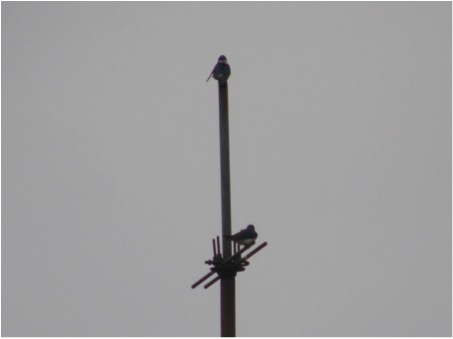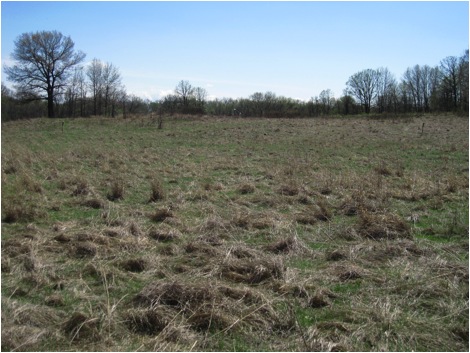TreeSwallow
Contact
Katharine Ordway Natural History Study Area9550 Inver Grove Trail Inver Grove Heights, MN 55076 651-455-6204 (On Site)
651-696-6230 (On Campus)
andersonm@macalester.edu
Biotic Inventory: Documenting Diversity at the Katharine Ordway Natural History Study Area
Tachycineta bicolor: Tree Swallow

Taxonomy:
Kingdom-Animalia
Phylum-Chordata
Class-Aves
Order-Passeriformes
Family-Hirundinidae
Genus-Tachycineta
Species-T. bicolor
Common Name-Tree Swallow
Diagnostic Characteristics
Tree Swallows are small, slender songbirds (also known as perching birds) easily identified by their pure white belly and throat with a glossy, blue-green head, shoulders, back, and tail. The males tend to be slightly more colorful (their blue sheen is more distinct), and both sexes possess more striking coloration in the spring and summer, as their coat changes to a more grayish green in the fall 2,3.
While in flight, they can be characterized by their long, narrow wings and forked, V-shaped tail. These birds are approximately 4.7 to 5.9 inches in length (12 to 15 centimeters) and have an 11.8 to 13.8 inch (30 to 35 centimeter) wingspan. They weight about 0.6 to 0.9 ounces (16 to 25 grams) 1.
Ecology
Habitat–These animals are often found in open areas near lakes, ponds, or other sources of water. Any type of grassland or open field in close proximity to water is preferable, although Swallows especially like fields next to forested habitats as well, where they can establish safe nesting and perching sites 4.
Diet-Tree Swallows feed on flying insects and various types of berries, the latter of which helps them survive poor weather when insect populations could be sparse. For their insect diet, the birds’ preys of choice are flies, beetles, ants, and grasshoppers, which they usually catch and eat while on the wing 4.
Migration Patterns-Being migratory birds, Tree Swallows can travel large distances over the course of their short lives. Many populations travel south to Florida and the Caribbean coast for the winter months, and migrate as far north as the Canadian tree line during the summer breeding season; Mating pair are primarily monogamous, although extra-pair copulations are not uncommon, and many parents have been studied raising nestlings not fathered by the resident male 3.
General Behavior-While Tree Swallows are highly social in the fall and winter time, they are fiercely territorial during the breeding season. They harass any bird species that come within a 10 to 15 meter radius of their nest due to high competition for nesting space. Each nesting pair is decisively rooted to their territory, and they rarely venture outside this nesting zone while raising their young.
Outside of the summer breeding season, Tree Swallows congregate in huge flocks with individuals often numbering in the thousands. These groups can be seen roosting in the trees together while spending little time on the ground, as their name would suggest. They migrate during the day and are more prone to glide while in flight than most perching birds 3.
Communication-Tree Swallows use a variety of forms of body language and calls to communicate with each other. Only males can sing, which is thought to be used for proclaiming their territory. Various other verbal and body signals include a crouching, wing fluttering, and as many as 14 different calls used by both sexes.
Nesting-They make their nests in any type of cavity, usually in holes in trees previously hallowed out by woodpeckers; Tree Swallows have also been known to nest in bird boxes, under the eaves of buildings, and other manmade structures. The nests, which are built almost exclusively by the female, are constructed from cocktail of grasses, mosses, rootlets, aquatic plants, and feathers from other species of birds. The latter ingredient helps in containing the female’s body heat during incubation and helps deter mites and other pests 3, 4.
Predation– Being one of the New World’s most populous and widely distributed avian species, Tree Swallows make plentiful prey for many of North America’s generalist predators and birds of prey. Some of the most common predators of Tree Swallow nestlings and eggs include: rat snakes (Elaphe obsolete), raccoons (Procyon lotor), and feral cats (Felis silvestris). Adults are also preyed upon by many species, such as sharp-shinned hawks (Accipter striatus), American kestrels (Falco sparverius), great horned owls (Bubo virginianus), and peregrine falcons (Falco peregrinus) 3.
When under attack, Tree Swallows will swarm and dive-bomb their predators; they will also issue alarm calls to any other Swallows in the surrounding area 3.
These birds are harassed in other ways as well. A variety of organisms parasitize Tree Swallows, most notably blowfly larvae (Family Calliphoridae) 3.
Life History
A pair of Tree Swallows will raise only one brood per breeding season, with the female usually laying anywhere from 2 to 8 eggs. The female incubates her clutch for about 15 days before the young are ready to hatch. Once the brood has broken from their shells, both parents are responsible for catching food for and feeding the nestlings. The young typically eat insects just like the adults 1.
About 15 to 25 days after hatching, the juveniles are ready to leave fledge from the nest, although the parents will often continue to feed their children for several days following their newfound independence. Upon first leaving the nest, these juveniles will sport a relatively dull, sooty grey coat of feathers along their head, back, wings and tail, with only traces of blue and a relatively dull white underside. These less-attractive versions of their parents will take about one year to become sexually mature. If their growth is timed properly, they will be ready to mate by the following summer 2, 3.
Unfortunately for the birds, they will not have loads of time to reproduce once they are ready to mate. The average life span of a Tree Swallow is only about 2.7 years, although it is not uncommon for certain individuals to live considerably longer. The oldest Tree Swallow ever recorded was approximately 11 years old 3.
Distribution
As stated earlier, Tree Swallows are an incredibly common and widespread species. They inhabit nearly all of North America, with their northernmost summer breeding grounds extending to the Canadian tree line. Many flocks migrate to parts of the southern United States, particularly Florida, as well as many areas of Central America during the winter time. When not breeding in the U.S., they can be found in Mexico, the Dominican Republic, Cuba, Guatemala, and other subtropical countries. However, they are not found on any continent besides North America 2, 4.
Voucher Information
The pair of Tree Swallows pictured above were photographed at the Katherine Ordway Natural History Study Area next to the Mississippi River in Inner Grove Heights, Minnesota. The field house was located approximately 17 miles from Saint Paul. They were observed flying over the prairie habitat and entering a bird box. Assuming these specimens were a mated pair, the bird box and surrounding prairie was likely their territory for the upcoming summer. The picture was taken at approximately 11:30am on April 16th, 2010.

References
C Chipper Woods Bird Observatory.2009.http://www.wbu.com/chipperwoods/photos/treeswallow.htm
- The Cornell Lab of Ornithology.2009.http://www.allaboutbirds.org/guide/Tree_Swallow/id
- University of Michigan Museum of Zoology.2009.http://animaldiversity.ummz.umich.edu/site/accounts/information/Tachycineta_bicolor.html
- Seattle Audubon Society for Birds and Nature.2008.http://www.seattleaudubon.org/birdweb/bird_details.aspx?id=322.
Compiled byTodd Robert Bollinger
Biodiversity & Evolution (BIOL 270) Professr Sarah Boyer. Spring 2010
Specimen collected at Macalester College’s Katharine Ordway Natural History Study Area on April 15, 2010.